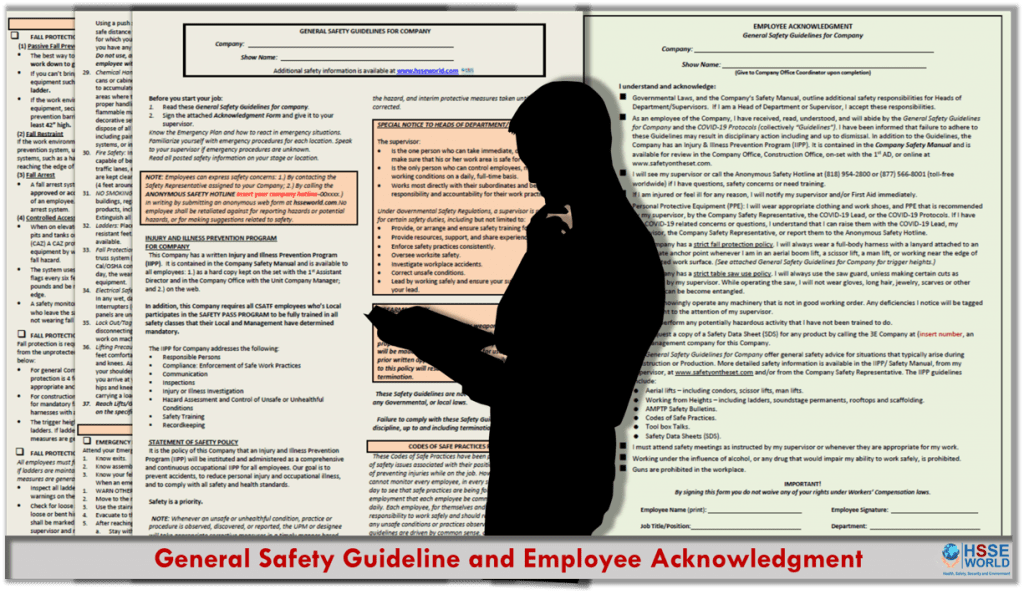General Safety Guidelines and Employee Acknowledgment form
3 min readThe main goal of safety and health programs is to prevent workplace injuries, illnesses, and deaths, as well as the suffering and financial hardship these events can cause for workers, their families, and employers. The recommended practices use a proactive approach to managing workplace safety and health. Traditional approaches are often reactive –that is, problems are addressed only after a worker is injured or becomes sick, a new standard or regulation is published, or an outside inspection finds a problem that must be fixed. These recommended practices recognize that finding and fixing hazards before they cause injury or illness is a far more effective approach.
in this article, HSSEWORLD provide proactive form as following
- General Safety Guidelines for the company.
- Acknowledgment Form.
since the Employees, prior to starting his job he shall read the General safety guideline of his company and sign the Acknowledgment form then submit it to his supervisor

General Safety Guidelines for the company
shall be addressed and distributed to all employees prior to starting the job to have a short brief about all workplace hazards and safety practices the Guideline include the following topics
- General
- Emergency information
- In the Event of Fire
- Fire Extinguishers
- Fire Prevention
- Emergency plan
- Working At Heights
- Fall protection: Definitions & Guidelines
- Fall protection: Trigger Heights
- Fall Protection: General Ladder Safety
- Fall Protection: Fixed Ladder
- Fall Protection: Soundstage Permanents
- Fall Protection: Horizontal Cable system over permanents
- Fall Protection: Below the Permanents single rope grab system
- Fall Protection: Below the Permanents multiple rope grab system
- Fall Protection: Rooftop Restraint
- Fall Protection: Controlled Acess zone
- Fall Protection: In the event of Fall
- Hazard Coummunications
- Lockout/Tagout
- Trenching and shoring
- Lifting
- Heat Illness
- Scaffold user awareness
- Blood born Precautions
- Personal Protective Equipment (PPE)
- Tools
- Welding /cutting
- Indoor Crane ( HOIST)
- Compressed Air
- Rope and chain
- Vehicles and heavy equipment
- Crane Operation Awareness
- Aerial Platforms
- Electric Carts
- Bicycles
- Set walls
The supervisor:
- Is the one person who can take immediate, direct action to make sure that his or her work area is safe for their employees.
- Is the only person who can control employees, machines, and working conditions on a daily, full-time basis.
- Works most directly with their subordinates and bears responsibility and accountability for their work practices.
Under Governmental Safety Regulations, a supervisor is responsible for certain safety duties, including but not limited to:
- Provide, or arrange and ensure safety training for subordinates.
- Provide resources, support, and share the experience.
- Enforce safety practices consistently.
- Oversee worksite safety.
- Investigate workplace accidents.
- Correct unsafe conditions.
- Lead by working safely and ensure your subordinates follow your lead.
These Safety Guidelines are not intended as a legal interpretation of any Governmental or local laws.
Failure to comply with these Safety Guidelines may result in discipline, up to and including termination.
Download the forms
General Safety Guidelines for the company.

Editable Form.DOC
Reding form.PDF
Employee Acknowledgment Form

Editable Form.DOC
Reding form.PDF
More Forms
- Camp Inspection form
- Machines Access Control Inspection Checklists
- Lift Plan Form
- Slips,Trips and Falls checklist
- Emergency Drill Table Top meeting Form
- Emergency Drill After Action Review form
- Compressed Gas Cylinders Access Control Inspection Checklist
- Competent Person Designation form
- Contractor Weekly HSE Report Form
- Safety Inspection Form
- Incident Report Form
- Job Hazard Analysis form
- OSHA Inspection Checklist 8-Pages
- Process Safety Management (PSM) Compliance checklist
- Portable Ladder Self Inspection checklist
- Scaffold Register and Inspection Checklist
- CRANE INSPECTION REPORT
- Laboratory Inspection Checklist Form
- Electric Arc Welding and Cutting Checklist
- Crane Suspended Personnel Platform (MANBASKET) Permit
- Pressure Testing Checklist
- Hygiene and Sanitation Inspection Checklist
- Permit to Work (PTW ) AUDIT CHECKLIST
- Equipment Safe Operating Procedures- SOP 61 checklist
- Construction safety Inspection checklist
- Fall safety at construction checklist
- Contractor Pre-qualification Questionnaire Checklist
- Lifeline & Harness Inspection Guide checklist
- Templates: Management of Change NEW Modified Equipment Safety Checklist
- Lock Removal Form
- Workplace Safety Inspections Forms
- Safety Templates: COVID-19 Safety Plan
- Construction Site Traffic Management Plan (CSTMP) Guidance
- Fire Pump Daily Inspection Checklist
- Health Safety at Work Improvement Action Plan
- Work at Height Checklist
- Canteen Inspection Checklist
- Electrical Isolation Permit to Work forms and checklist
- Job Safety Analysis (JSA) Forms What’s Right and Wrong?
- Lifting Plan Audit Checklist
- ISO 45001:2018 READINESS CHECKLIST
- Workplace Housekeeping Checklist
- Hazard Identification Checklist
- Free Pre-Startup Safety Review Checklist (PSSR)
- Ladder Inspection Form
- Hazard Identification Plan (HIP) Template
- HIRA, HSE Hazards & Effects Management Process (HEMP) & Risk Register Template
- Temporary Construction Facilities (TCF) Inspection checklist
- Simultaneous Operation (SIMOPS) checklist
- Mobile Scaffold Inspection checklist
- Annual Internal Audit Form
- General Safety Guidelines and Employee Acknowledgment form
- E-Books: Fire Safety Logbook templates
- Electrical Inspection Checklists
- Grating-Decking-Floor- handrail-Removal Form
- Photo of the day: New worker Orientation & Safety Orientation checklist
- Suspended Scaffold Pre-Operation Inspection Checklist



